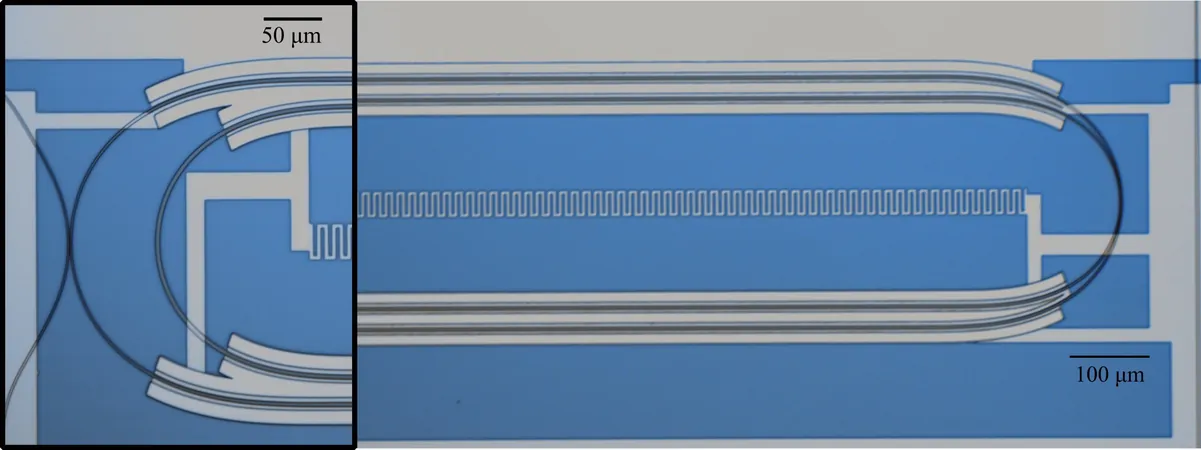
Revolutionary Photon Router Paves Way for Superconducting Quantum Networks!
2025-04-02
Author: Mei
In an exciting development from the Harvard John A. Paulson School of Engineering and Applied Sciences (SEAS), a team of applied physicists has unveiled a groundbreaking photon router capable of integrating into future quantum networks. This innovation promises to establish strong optical interfaces for microwave quantum computers, marking a significant step toward achieving modular and distributed quantum computing systems.
Led by esteemed researcher Marko Lončar, the Tiantsai Lin Professor of Electrical Engineering and Applied Physics at SEAS, the team has engineered a microwave-optical quantum transducer. This remarkable device is specifically designed for quantum processing frameworks that utilize superconducting microwave qubits—analogous to the classical bits used in today's technology. Published in the reputable journal *Nature Physics*, this research presents a leap forward in the realm of quantum computing.
So, how does the transducer work? As a sort of "router for photons," it effectively bridges the considerable energy gap between microwave and optical photons. This enables the management of superconducting qubits using optical signals from miles away, making it the first-ever device to demonstrate control over a superconducting qubit using only light.
Graduate student Hana Warner, the paper's lead author, emphasized the potential of optical systems. “Although we are still on the journey towards practical quantum networks, tapping into optics offers efficient pathways for scaling and interfacing the various components,” she explained. Optical photons are particularly appealing due to their capabilities to carry data with minimal loss and immense bandwidth.
One of the most critical challenges in deploying superconducting quantum computing platforms is the necessity for extremely low operating temperatures, which requires bulky dilution refrigerators. By leveraging optical photons as efficient and scalable interfaces, researchers hope to revolutionize how qubit operations are performed.
The Harvard team's transducer, measuring just 2 millimeters and shaped like a paper clip, operates on a chip that is 2 centimeters long. It connects a microwave resonator with two optical resonators, facilitating a seamless exchange of energy. This clever integration eliminates the reliance on cumbersome, hot microwave cables typically used for qubit control.
As a remarkable bonus, the same devices that control qubit states can also enable the reading of those states or form direct links that convert sensitive quantum information into robust packets of light for smooth transmission across quantum computing nodes. This advancement inches us closer to the vision of interconnected superconducting quantum processors linked by high-powered optical networks.
Looking ahead, Professor Lončar envisions further applications for their transducer, including the reliable generation and distribution of entangled states between microwave qubits using light—an essential feature for advancing quantum computing.
Collaborating with Rigetti Computing, which supplied the aluminum-on-silicon superconducting qubit platforms for experimentation, the Harvard researchers combined their optical expertise with inputs from collaborators at the University of Chicago and Massachusetts Institute of Technology. Chip fabrication took place at Harvard's Center for Nanoscale Systems, reflecting the convergence of cutting-edge technology and collaborative innovation in nanotechnology.
As the race for quantum supremacy heats up, this discovery ignites hopes for a brighter, ultrafast quantum future! Are we on the brink of a computing revolution? Only time will tell!


 Brasil (PT)
Brasil (PT)
 Canada (EN)
Canada (EN)
 Chile (ES)
Chile (ES)
 Česko (CS)
Česko (CS)
 대한민국 (KO)
대한민국 (KO)
 España (ES)
España (ES)
 France (FR)
France (FR)
 Hong Kong (EN)
Hong Kong (EN)
 Italia (IT)
Italia (IT)
 日本 (JA)
日本 (JA)
 Magyarország (HU)
Magyarország (HU)
 Norge (NO)
Norge (NO)
 Polska (PL)
Polska (PL)
 Schweiz (DE)
Schweiz (DE)
 Singapore (EN)
Singapore (EN)
 Sverige (SV)
Sverige (SV)
 Suomi (FI)
Suomi (FI)
 Türkiye (TR)
Türkiye (TR)
 الإمارات العربية المتحدة (AR)
الإمارات العربية المتحدة (AR)